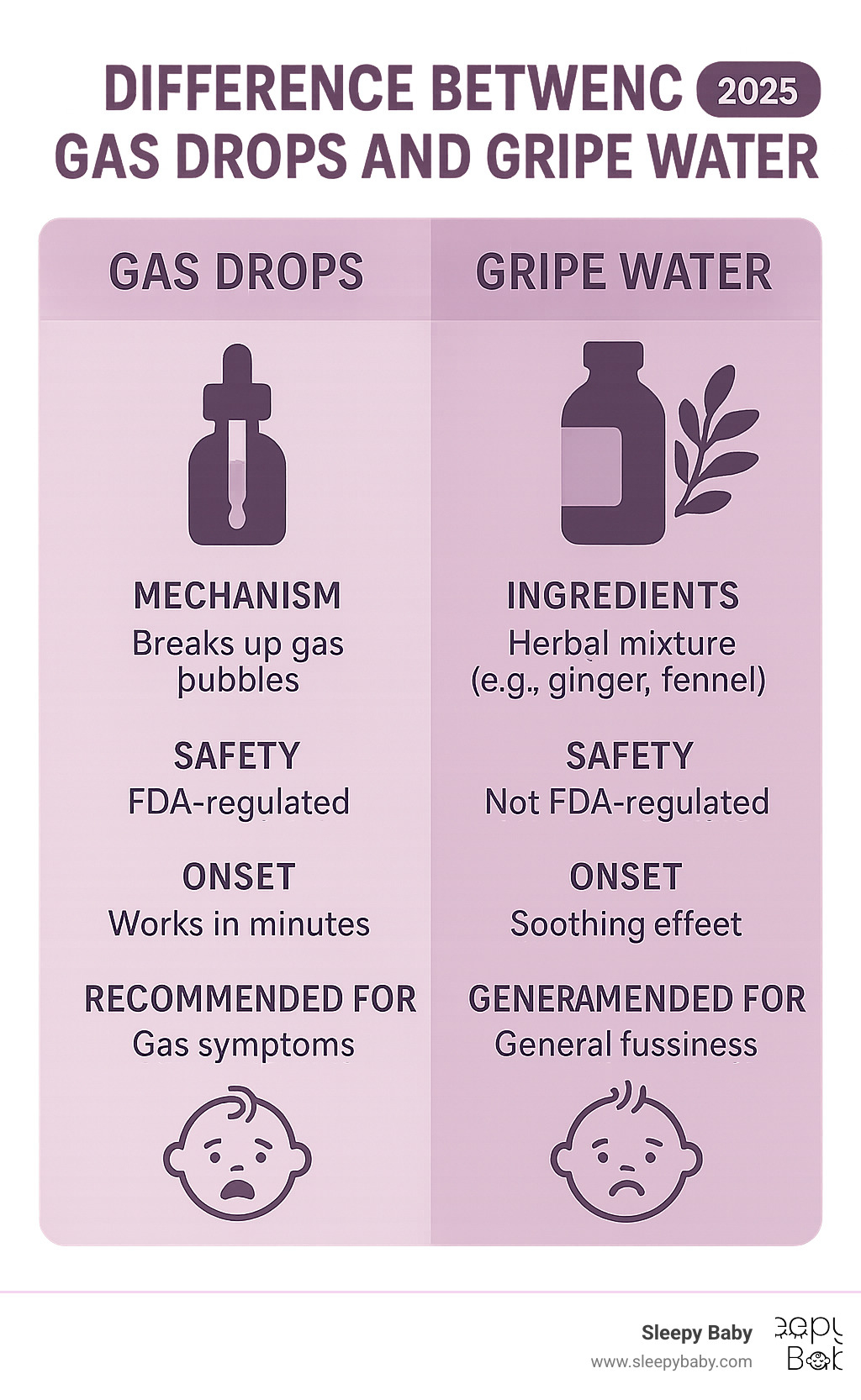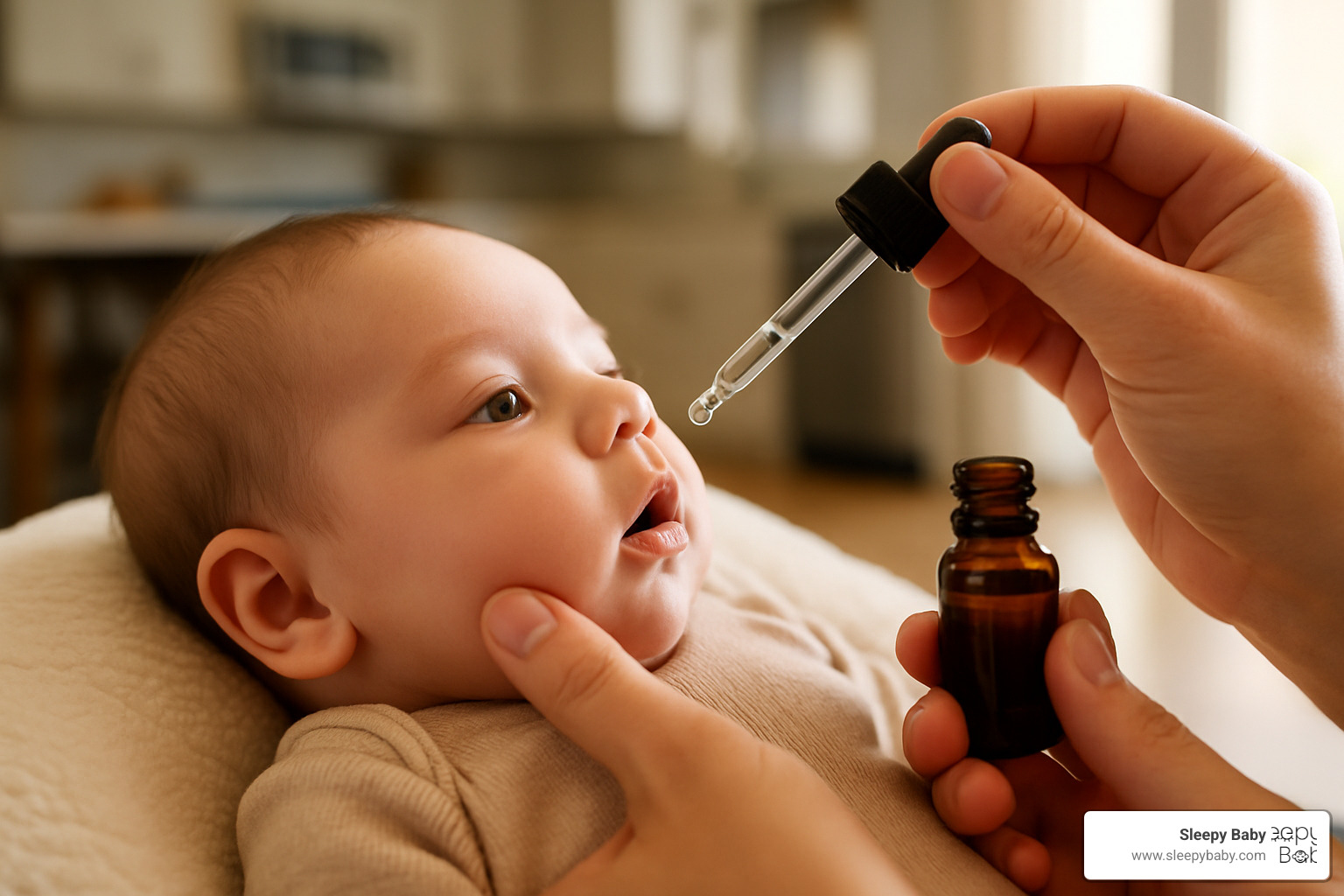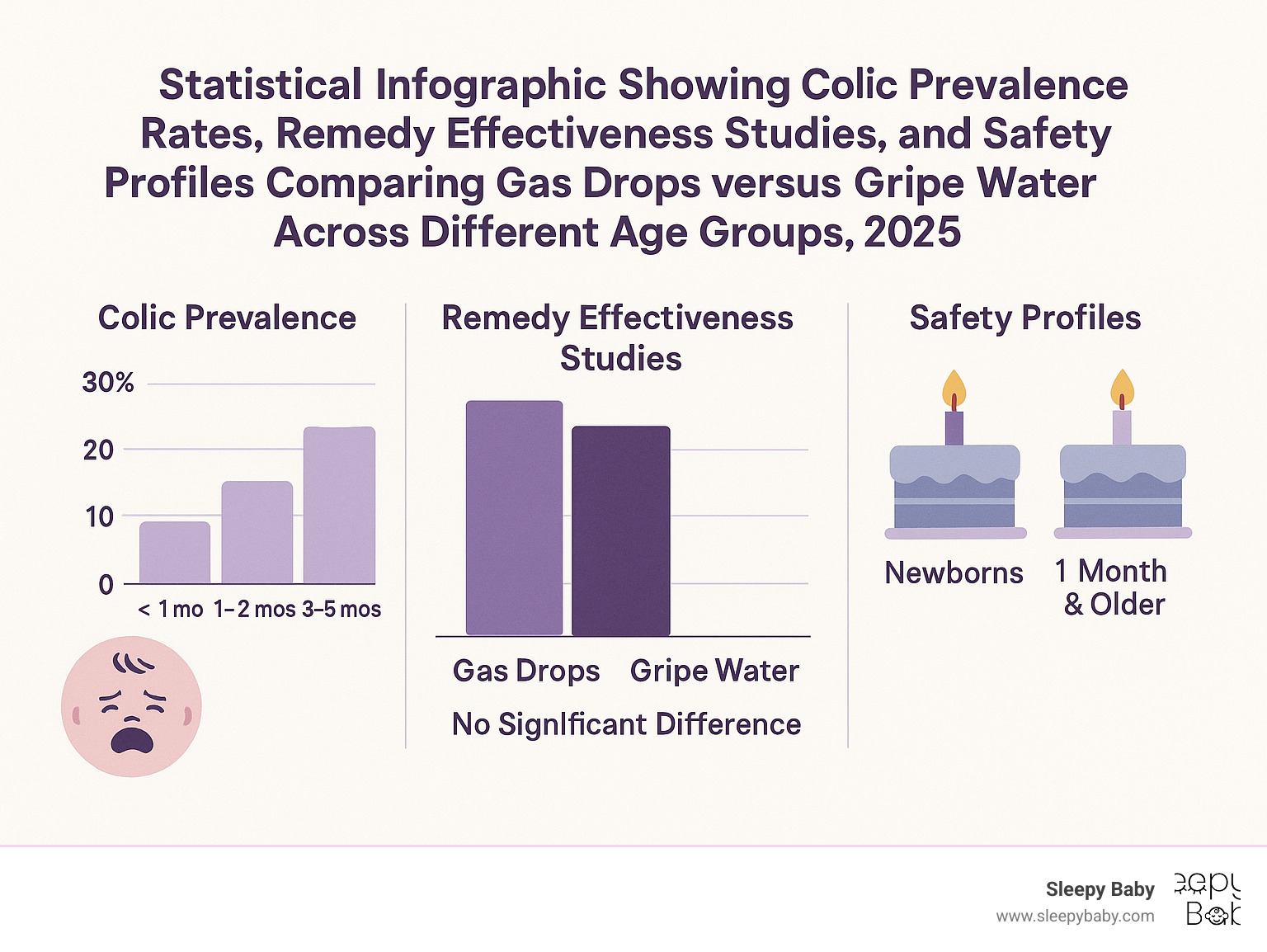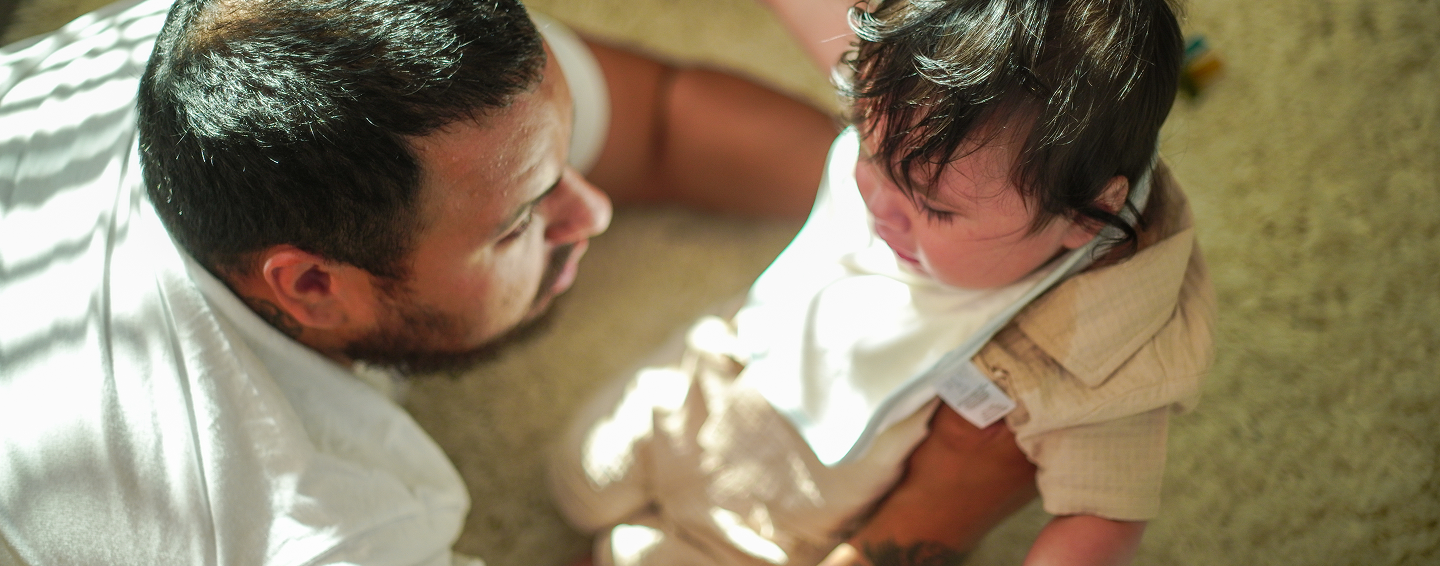Why Understanding Baby Gas Relief Options Matters for Desperate Parents
The difference between gas drops and gripe water becomes crystal clear when you're holding a screaming baby at 3 AM. About 20% of babies develop colic, and parents will try almost anything to bring relief to their little ones and themselves.
Quick Answer: Gas Drops vs Gripe Water
- Gas Drops (Simethicone): Break up gas bubbles, FDA-regulated, work in minutes, safe for newborns
- Gripe Water: Herbal mixture with ginger/fennel, not FDA-regulated, variable ingredients, soothing effect
- Main Difference: Gas drops target trapped gas specifically, while gripe water addresses general digestive discomfort
- Safety: Gas drops have consistent dosing and regulation; gripe water quality varies by brand
Both remedies aim to soothe fussy babies, but they work through completely different mechanisms. Gas drops use simethicone to physically break apart gas bubbles in your baby's stomach. Gripe water relies on herbal ingredients like ginger and fennel to calm the digestive system overall.
The choice between them often comes down to your baby's specific symptoms. If you see clear signs of trapped gas - like a hard belly, leg pulling, or crying after feeding - gas drops might be your best bet. For general fussiness and colic symptoms, some parents find gripe water more soothing.
As Gary Harutyunyan, a father who struggled through sleepless nights with a colicky baby, I've researched every possible solution including the difference between gas drops and gripe water to help families find relief. My experience creating the Sleepy Baby device taught me that understanding these remedies is just one piece of the puzzle for exhausted parents.

The Science Behind Infant Gas Relief
When you're dealing with a fussy baby, understanding the difference between gas drops and gripe water starts with knowing why those tiny tummies get so uncomfortable. Baby digestive systems are still learning their job - they're immature and prone to gas buildup from swallowed air during feeding, crying, or just from the normal digestion process.
The good news? Both remedies work, but they take completely different approaches to solving the same problem. It's like having two different tools in your parenting toolkit - one that fixes the immediate issue and another that soothes the whole system.
Simethicone (the active ingredient in gas drops) works like a tiny bubble-popping machine inside your baby's tummy. Research shows it reduces surface tension, allowing those painful little gas bubbles to combine into bigger ones that are much easier for your baby to pass. The best part? It's not absorbed into your baby's bloodstream at all - it just does its job and exits naturally.
Gripe water takes the gentle, holistic route. The herbal ingredients like ginger and fennel have been calming upset tummies for centuries, and modern research confirms they really do work. Ginger improves how quickly food moves through the digestive system, while fennel helps relax intestinal muscles and reduce spasms.
Here's something interesting that many parents don't realize: the placebo effect plays a real role, especially with gripe water. When you feel calmer giving your baby something that might help, your little one often picks up on that reduced stress and responds positively. Sometimes the soothing ritual of administering the remedy is just as important as the ingredients themselves.
Your baby's microbiome - all those good bacteria in their gut - is still developing too. This is why some babies seem more sensitive to gas and digestive issues than others. Both remedies work alongside this natural development process rather than interfering with it.
For more detailed information on the science behind gas relief, check out our Scientific research on simethicone and Gas Relief 101: Easing Your Baby's Discomfort.
How Gas Drops Work
Think of simethicone as nature's bubble wrap popper. When your baby has trapped gas, it's often because tiny bubbles are stuck in their digestive system. These small bubbles are actually harder to pass than larger ones - counterintuitive, right?
Simethicone works by reducing surface tension of these gas bubbles. Picture soap bubbles in your sink - when you add dish soap, the bubbles break apart and combine. That's essentially what's happening in your baby's tummy, but in reverse - the small, painful bubbles join together to form larger ones that can move through the digestive system more easily.
The anti-foaming action happens quickly, usually within minutes of giving the drops. Most gas drops contain about 20mg of simethicone per dose, and you can give them up to 12 times per day as needed. Because the medication isn't absorbed into your baby's system, it's considered very safe even for newborns.
What makes this mechanism so effective is its specificity. If your baby's crying is truly from trapped gas, simethicone directly addresses the physical cause without affecting any other body systems. It's like having a very precise tool that does exactly one job really well.
How Gripe Water Works
Gripe water is more like a gentle, multi-tasking friend for your baby's digestive system. Instead of targeting one specific problem, it works on multiple levels to create overall comfort.
Ginger root extract (typically around 5mg per serving) is the star player here. Research shows it improves gastrointestinal motility - basically helping food and gas move through your baby's system more smoothly. It also increases gastric emptying, which means less time for gas to build up in the first place.
Fennel seed extract (usually 4-5mg per serving) works as a natural muscle relaxer for the intestines. It reduces spasms and promotes the natural wave-like movements that help digestion. Many parents notice their babies seem more comfortable overall after fennel-based gripe water.
Some gripe waters contain sodium bicarbonate, which acts as an alkalizing agent. This helps neutralize excess stomach acid that might be contributing to discomfort. It's the same principle as when adults take antacids, just in much smaller, baby-appropriate doses.
Here's something fascinating about timing: how quickly your baby responds to gripe water can actually tell you what was bothering them. Instant relief often means the natural sugars (present in some formulations) provided a calming effect. Relief in 2-10 minutes suggests the alkalizing agents helped with acid issues. If relief comes after 10+ minutes, the herbal ingredients are likely working their magic on digestive muscles.
The smooth-muscle relaxation effect is particularly helpful for babies who seem to have general digestive discomfort rather than specific gas bubbles. It's why some parents swear by gripe water for overall fussiness, even when gas doesn't seem to be the main issue.
Key Differences Between Gas Drops and Gripe Water
When you're standing in the baby aisle at 2 AM wondering which remedy to grab, the difference between gas drops and gripe water becomes more than academic - it's about getting your little one (and yourself) some much-needed relief.
The most important distinction is regulation. Gas drops are FDA-regulated medications with standardized ingredients and dosing, while gripe water is classified as a dietary supplement with no required safety testing. This means when you buy gas drops, you know exactly what you're getting. With gripe water, ingredients can vary dramatically between brands.
Gas drops work faster and more predictably. The simethicone starts breaking up gas bubbles within 2-10 minutes, and the dosing is standardized at 0.3mL regardless of brand. Gripe water's timing is all over the map - sometimes you'll see instant relief from the sugar content, other times it takes 15+ minutes for the herbal ingredients to kick in.
The safety profiles tell different stories too. Gas drops have been extensively studied with consistent results, while gripe water has faced multiple recalls over the past 15 years for bacterial contamination. One particularly scary case involved a 9-month-old who developed septic shock from contaminated gripe water.
| Aspect | Gas Drops | Gripe Water |
|---|---|---|
| Regulation | FDA-regulated | Not FDA-regulated |
| Active Ingredient | Simethicone only | Variable herbal blend |
| Onset Time | 2-10 minutes | Instant to 15+ minutes |
| Mechanism | Physical bubble breakup | Multi-pathway soothing |
| Dosing | Standardized (0.3mL) | Varies by brand |
| Safety Profile | Consistent, well-studied | Variable, recall history |
| Age Suitability | Safe from birth | Check with pediatrician |
Mechanism of Action: The Difference Between Gas Drops and Gripe Water Explained
Here's where the science gets interesting. The difference between gas drops and gripe water is like comparing a precision tool to a Swiss Army knife.
Gas drops work through pure physics. The simethicone acts like a bubble-popping agent, breaking the surface tension that holds tiny gas bubbles together. Those smaller bubbles combine into larger ones that your baby can actually pass. It's immediate, specific, and predictable.
Gripe water takes the shotgun approach. The ginger stimulates smooth muscle relaxation in your baby's digestive tract, while fennel reduces intestinal spasms. Meanwhile, sodium bicarbonate neutralizes stomach acid that might be contributing to discomfort. Some formulations add citric acid to create a gentle alkalizing effect.
This multi-pathway approach means gripe water can address various types of digestive upset beyond just gas. But it also means the effects are less predictable. What works amazingly for your neighbor's baby might do nothing for yours.
Formulation & Safety: The Difference Between Gas Drops and Gripe Water in Real-World Use
Modern gripe water has come a long way from its sketchy origins. The original Victorian-era versions were basically baby cocktails - loaded with alcohol and sugar to sedate fussy infants rather than actually treat anything. Today's formulations are typically alcohol-free, though many still contain sugar.
The challenge is that without FDA oversight, ingredients vary dramatically between brands. Some gripe waters still use sugar (which does have documented pain-relieving effects in infants), while others use artificial sweeteners or skip sweeteners entirely. The concentration of active herbal ingredients is anyone's guess.
Gas drops, by contrast, are boringly consistent - and that's a good thing when it comes to your baby's safety. The simethicone concentration is standardized, and inactive ingredients are clearly labeled. Most formulations are free from alcohol, sugar, gluten, and artificial colors.
The allergy risk tells the whole story. Gas drops have minimal allergy potential since simethicone isn't absorbed into your baby's system. Gripe water, with its variable herbal cocktail, carries higher allergy risks. The American Academy of Pediatrics has documented serious allergic reactions to gripe water ingredients.
For parents who want to dig deeper into the research, check out the Scientific research on gripe water safety for a comprehensive look at documented safety concerns.

How to Choose the Right Remedy for Your Baby
Choosing between gas drops and gripe water shouldn't be a guessing game. We've developed a systematic approach to help you identify which remedy best matches your baby's symptoms.
Gas Drop Indicators:
- Hard, distended belly
- Pulling legs up toward stomach
- Crying immediately after feeding
- Visible relief after burping or passing gas
- Crying that stops when pressure is relieved
Gripe Water Indicators:
- General fussiness without clear gas signs
- Crying at predictable times (often evenings)
- Difficulty settling even when not hungry
- Overstimulation or overtiredness
- Hiccups alongside fussiness
Red Flag Symptoms (Call Pediatrician):
- Fever over 100.4°F (38°C)
- Blood in stool
- Blue lips or skin
- Projectile vomiting
- Refusing to eat
- Extreme lethargy
Before trying any remedy, consult your pediatrician, especially if your baby is under 1 month old or was born prematurely. They can help you determine whether symptoms indicate gas, colic, reflux, or another condition requiring different treatment.
For a comprehensive guide to selection, visit our Step-by-Step Guide to Choosing Effective Infant Gas Drops.
Decision Tree: Gas Drops, Gripe Water, or Both?
Age Considerations:
- Newborns (0-1 month): Gas drops are generally preferred due to consistent dosing and safety profile
- 1-3 months: Either option can be appropriate based on symptoms
- 3+ months: Both options are typically safe, but many babies outgrow the need
Can You Use Both? Using gas drops and gripe water together isn't recommended without pediatric guidance. The combination hasn't been studied for safety or efficacy, and it makes it difficult to determine which remedy is helping. If one remedy isn't working after a few days, consider switching rather than combining.
Dosing Guidelines:
- Gas Drops: Standard dose is 0.3mL up to 12 times daily
- Gripe Water: Follow package instructions carefully as concentrations vary by brand
Timing Considerations: If you do use both remedies (with pediatric approval), space them at least 30 minutes apart to avoid overwhelming your baby's digestive system and to better assess which is providing relief.
Non-Medicinal Alternatives to Try First
Before reaching for any remedy, try these gentle, non-medicinal approaches that often provide significant relief:
Burping Techniques:
- Burp every 1-2 ounces during feeding
- Try different positions: over the shoulder, sitting upright, lying on your forearm
- Gentle back patting combined with circular motions
Tummy Massage:
- Use gentle circular motions clockwise around the belly button
- "I Love U" massage technique on the abdomen
- Warm your hands first for added comfort
Movement and Positioning:
- Bicycle legs gently to help gas move through the system
- Hold baby upright for 15-20 minutes after feeding
- Try the "colic carry" - baby face-down along your forearm
Environmental Soothing:
- White noise or rhythmic sounds
- Swaddling for comfort and security
- Gentle rocking or walking
At Sleepy Baby, we've found that our rhythmic patting sleep aid complements these techniques beautifully. The gentle, consistent motion mimics a caregiver's soothing touch while freeing your hands for other comfort measures.
For more detailed techniques, check out From Bloat to Bliss: Relieving Gas Pains Quickly.
Safe Use, Potential Risks, and When to Call the Pediatrician
When you're desperate for relief at 2 AM, it's easy to think "more is better" with infant remedies. But understanding the difference between gas drops and gripe water includes knowing their potential risks and how to use them safely.
Gas drops have an excellent safety profile because simethicone isn't absorbed into your baby's bloodstream. Side effects are extremely rare, but there are a few things to watch for. The most important is giving the drops slowly to avoid choking - never squirt them quickly into your baby's mouth. While overdosing is nearly impossible, more isn't better, so stick to recommended doses.
One lesser-known consideration is that simethicone can potentially interfere with thyroid medications. If you're taking thyroid medication and breastfeeding, mention this to your pediatrician, though interactions are rare.
Gripe water carries more potential risks due to its variable ingredients and lack of FDA regulation. Allergic reactions to herbal ingredients like ginger or fennel can occur, especially in babies with sensitive systems. Watch for rashes, increased fussiness, or changes in breathing after giving gripe water.
The most serious risk is alkalosis - when blood becomes too alkaline from excessive sodium bicarbonate. This can happen if you give gripe water too frequently or in large amounts. Symptoms include vomiting, muscle twitching, and unusual irritability.
Perhaps most concerning are the contamination risks. Several gripe water brands have faced recalls due to dangerous bacteria like Cryptosporidium and Pseudomonas aeruginosa. Always check FDA recall notices before purchasing, and buy from reputable retailers who store products properly.
For evidence-based information about colic remedies, read our Colic Drops: Separating Fact from Fiction.

Combining Remedies Safely
Your pediatrician might approve using both gas drops and gripe water, but this requires careful attention to timing and dosing. The key is spacing them properly - wait at least 30 minutes between different remedies to avoid overwhelming your baby's system.
Maximum daily limits are crucial to remember. Gas drops can be given up to 12 times per day, while gripe water limits vary significantly by brand. Never exceed these recommendations, even if your baby seems comfortable with the remedies.
When using both, start with gas drops if you see clear signs of trapped gas like a hard belly or leg pulling. Use gripe water for general soothing when gas drops alone aren't providing enough relief.
Storage matters more than you might think. Keep gripe water in cool, dry conditions and check expiration dates regularly. Shake gas drops before each use, and always use clean droppers and measuring devices. Cross-contamination between remedies can introduce bacteria or affect dosing accuracy.
Warning Signs You Need Medical Help
Some symptoms require immediate attention, regardless of which remedy you're considering. Fever over 100.4°F is always a red flag in infants, as is any blood in stool or vomit. These aren't related to normal gas discomfort.
Blue lips, tongue, or skin indicate breathing problems that need emergency care. Similarly, difficulty breathing or unusual breathing patterns require immediate medical attention. These symptoms can indicate serious conditions that no home remedy can address.
Extreme lethargy or unresponsiveness is another emergency sign. Babies should be alert during wake periods, even when fussy. Projectile vomiting is different from normal spit-up and can indicate serious digestive issues.
Less urgent but still important signs include crying more than 3 hours daily for multiple days, significant changes in eating or sleeping patterns, or persistent gas symptoms despite treatment. These warrant a pediatric consultation within a day or two.
Colic typically resolves by 3-4 months of age. If symptoms persist beyond this timeframe, underlying medical conditions may need investigation. Trust your instincts - if something feels wrong, it's always better to call your pediatrician than to worry alone.
Frequently Asked Questions About the Difference Between Gas Drops and Gripe Water
Can I use gas drops and gripe water together?
While some parents report using both remedies, we don't recommend combining them without pediatric guidance. The safety and efficacy of using both together hasn't been studied, and it makes it difficult to determine which remedy is actually helping your baby.
If one remedy isn't providing adequate relief after 3-5 days of consistent use, consider switching to the other rather than combining them. This approach allows you to better assess effectiveness and avoid potential interactions.
If your pediatrician does approve using both, space them at least 30 minutes apart and never exceed the recommended dosage of either remedy.
Why does the difference between gas drops and gripe water matter for colic relief?
The difference between gas drops and gripe water matters because they target different aspects of infant discomfort. Understanding this helps you choose the most appropriate remedy for your baby's specific symptoms.
Gas drops work best when there's clear evidence of trapped gas - hard belly, leg pulling, crying after feeding. They provide targeted, fast-acting relief for this specific issue.
Gripe water addresses broader digestive discomfort and may be more effective for general colic symptoms, fussiness, or overstimulation. However, the lack of FDA regulation means effectiveness can vary significantly between brands.
Research shows that neither remedy has strong clinical evidence for colic relief, but many parents report success with one or the other. The key is matching the remedy to your baby's symptoms and using it safely under pediatric guidance.
Are these remedies safe for newborns long-term?
Gas drops are generally considered safe for long-term use in newborns because simethicone isn't absorbed into the bloodstream. However, most babies outgrow the need for gas relief by 3-4 months as their digestive systems mature.
Gripe water safety for long-term use is less clear due to variable ingredients and lack of standardized testing. Some herbal ingredients may interfere with nutrient absorption or cause other issues with prolonged use.
Both remedies should be viewed as temporary solutions while your baby's digestive system develops. Focus on identifying and addressing underlying causes of discomfort rather than relying on remedies indefinitely.
Always consult your pediatrician about long-term use of any remedy, especially if your baby continues to need frequent doses after 2-3 months of age.

Conclusion
The difference between gas drops and gripe water ultimately comes down to choosing the right tool for your baby's specific needs. Gas drops offer precise, science-backed relief for trapped gas bubbles, while gripe water takes a gentler, more holistic approach to general digestive discomfort.
If your little one has a hard belly and pulls their legs up after feeding, gas drops with their FDA-regulated simethicone might be your best bet. When you're dealing with general fussiness or evening colic that doesn't seem tied to specific gas symptoms, gripe water's herbal blend could provide the soothing your baby needs.
Neither remedy is a miracle cure for colic. Every baby is different, and what works wonders for your neighbor's little one might not help yours at all. That's completely normal and doesn't mean you're doing anything wrong.
The most important thing is to understand the difference between gas drops and gripe water so you can make informed decisions with your pediatrician's guidance. Gas drops offer consistency and regulation, while gripe water provides traditional comfort with more variable results.
At Sleepy Baby, we've learned that soothing fussy babies often requires a multi-pronged approach. Our rhythmic patting sleep aid works beautifully alongside any safe tummy remedy you choose. While gas drops or gripe water address digestive discomfort, our device provides the consistent, gentle comfort that mimics your soothing touch. This hands-free solution lets you focus on other comfort measures while ensuring your baby receives continuous calming.
Most babies outgrow gas and colic issues by 3-4 months as their digestive systems mature. Until then, be patient with yourself and your little one. Some nights will be harder than others, and that's okay. You're doing everything you can to help your baby feel better.
For comprehensive support during this challenging time, check out our Newborn Gas Relief Guide: Helping Your Little One Feel Better Fast. Together, we can help you find the right combination of comfort measures to give both you and your baby the peaceful nights you deserve.



